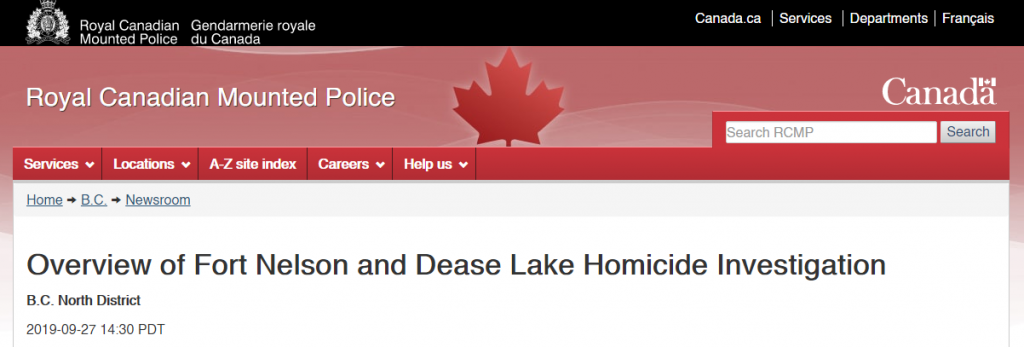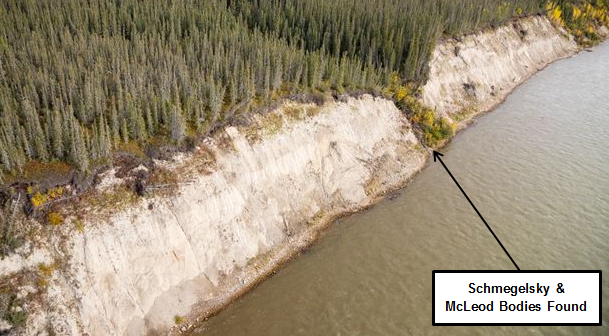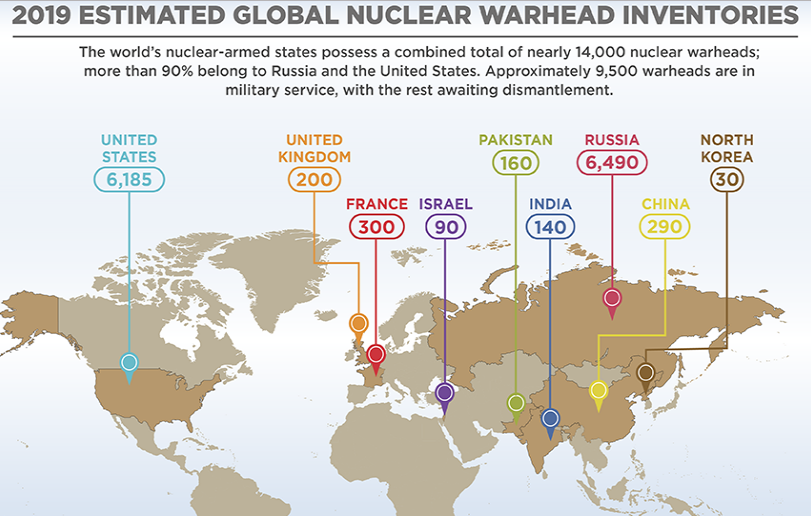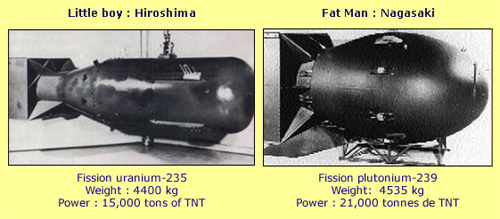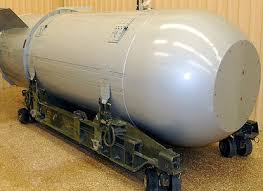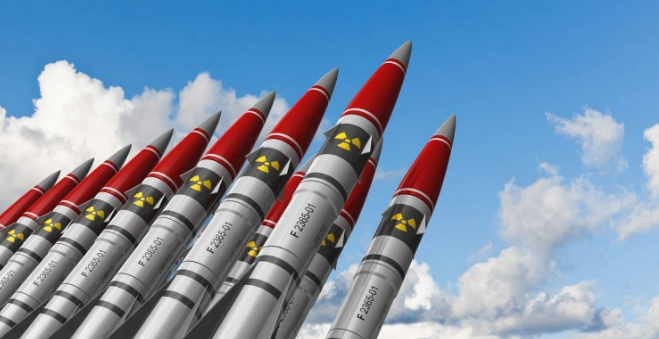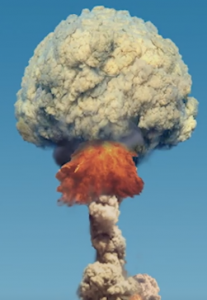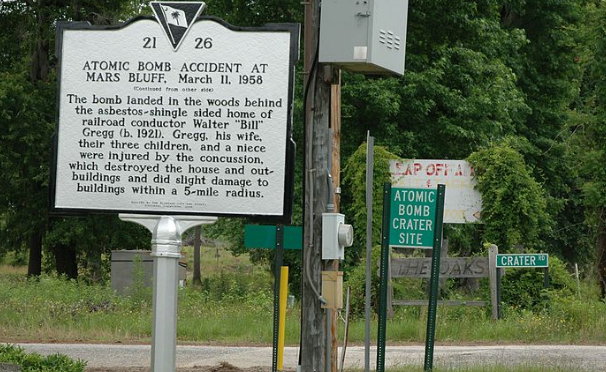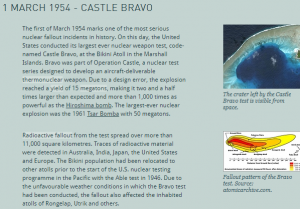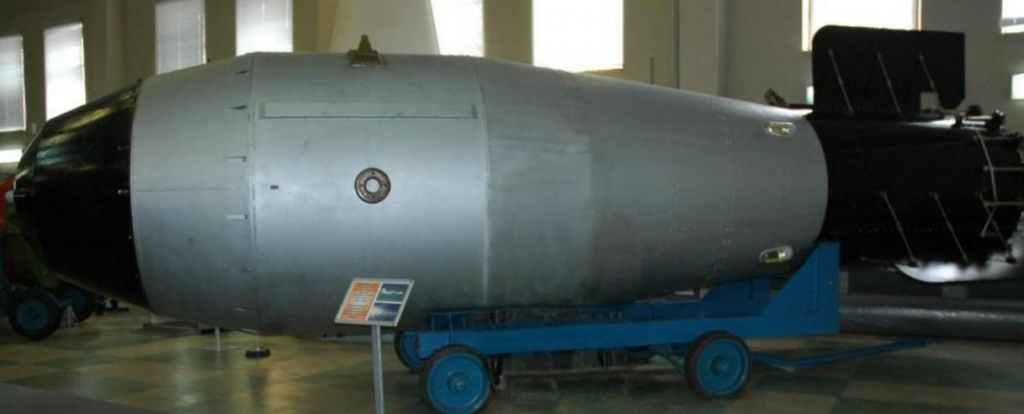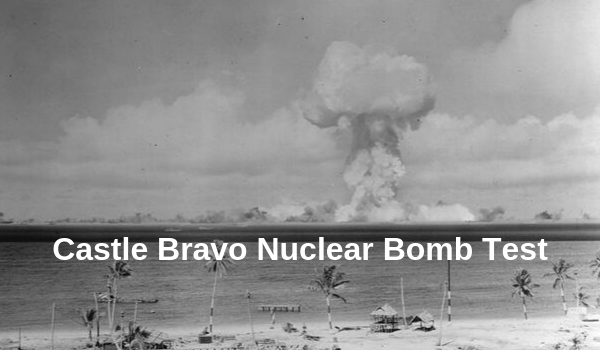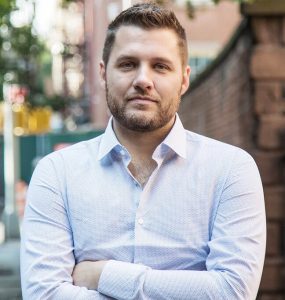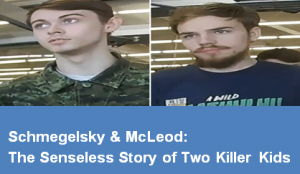 Two teens terrorized western Canada in July, 2019 with their murderous mission. These kids cold-bloodily killed three innocent victims before cowardly taking their own lives in a suicide pact. Their senseless spree sent shock worldwide through the international media because two victims were young American and Australian visitors. The third man—a Canadian senior.
Two teens terrorized western Canada in July, 2019 with their murderous mission. These kids cold-bloodily killed three innocent victims before cowardly taking their own lives in a suicide pact. Their senseless spree sent shock worldwide through the international media because two victims were young American and Australian visitors. The third man—a Canadian senior.
A national manhunt for 18-year-old Bryer Schmegelsky and 19-year-old Kam McLeod lasted 24 days. Hundreds of police officers led by the Royal Canadian Mounted Police (RCMP) searched for the outlaws using every tactical tool. They finally found Schmegelsky and McLeod dead in the Manitoba wilderness 2,000 miles (3,200 km) east of northern British Columbia where the teens executed their prey.
This week, the RCMP released their investigative report establishing beyond all doubt that Schmegelsky and McLeod acted together—and without aid—to commit three counts of first-degree murder. The report concludes the two teenagers fatally shot Chynna Deese, Lucas Fowler and Leonard Dyck before ending their own lives. What the RCMP report did not find was Schmegelsky and McLeod’s motive for these senseless acts that became an international news story about two killer kids.
The Deese and Fowler Murders
 Chynna Noel Deese was a 24 year old from Charlotte, North Carolina. Her 23-year-old boyfriend, Lucas Robertson Fowler, was from New South Wales in Australia. Fowler was in Alberta, Canada on a work visa, and Deese traveled up from the United States to join him on an adventure trip to the Canadian Yukon. On July 15, 2019, a road maintenance worker found their bullet-ridden bodies in a ditch along the Alaska Highway near Laird Hot Springs in British Columbia’s far north.
Chynna Noel Deese was a 24 year old from Charlotte, North Carolina. Her 23-year-old boyfriend, Lucas Robertson Fowler, was from New South Wales in Australia. Fowler was in Alberta, Canada on a work visa, and Deese traveled up from the United States to join him on an adventure trip to the Canadian Yukon. On July 15, 2019, a road maintenance worker found their bullet-ridden bodies in a ditch along the Alaska Highway near Laird Hot Springs in British Columbia’s far north.
This area is truly remote. The Deese-Fowler homicide scene was a 3.5-hour drive from Fort Nelson which had the nearest RCMP detachment. Uniform officers held the scene until detectives from the Northern BC Major Crimes Unit took over.
It was obvious that Deese and Fowler were intentionally shot multiple times. Autopsies and scene examination indicated the first wounds were from the back indicating they were taken by surprise. The detectives also recovered spent cartridge casings later identified as 7.62x39mm caliber rounds fired by two different Soviet-made SKS assault rifles.
Deese and Fowler’s murder motive baffled the detective team. There was no robbery or sexual assault evidence. The couple was completely clean of criminal connections. They seemed to have simply pulled off the road with temporary vehicle troubles when their lives were senselessly taken.
The RCMP had absolutely no idea—not a clue—why this happened. They had no suspects with nothing to go on but firearm evidence. They also had international media attention bearing down because of the victims’ citizenship and that Fowler’s father was a high-ranking Australian police officer.
Leonard Dyck’s Murder
While the RCMP investigation focused on the Deese and Fowler homicides, another body turned up fatally shot in northern British Columbia. This was on July 19, four days after Deese and Fowler were executed, and 250 miles (400km) to the British Columbia west as the crow flies, or a full day’s drive by the windy roads.
 The tiny village of Dease Lake, B.C. is on Highway 37 which is another northern road connecting the south with the north. Another highway worker found a burned-out truck with a dead body nearby at the Stikine River crossing just south of Dease Lake. It took three days for the police to identify 64-year-old Leonard Dyck as the deceased. Dyck was a botany professor from a Vancouver university who researched in British Columbia’s wilderness.
The tiny village of Dease Lake, B.C. is on Highway 37 which is another northern road connecting the south with the north. Another highway worker found a burned-out truck with a dead body nearby at the Stikine River crossing just south of Dease Lake. It took three days for the police to identify 64-year-old Leonard Dyck as the deceased. Dyck was a botany professor from a Vancouver university who researched in British Columbia’s wilderness.
Although it took the RCMP time to identify Leonard Dyck, they soon connected his homicide with Deese and Fowler’s demise. Dyck was also a gunshot victim and a matching SKS spent cartridge was near his remains. Now the police knew they had someone on a traveling murder spree, but they had no idea who or why.
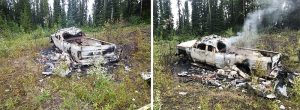 Detectives quickly identified the burned truck. It was an older Dodge Ram with a sleeper-canopy registered to a youth named Kam McLeod. There was no association to Leonard Dyck with this torched truck, and Dyck’s newer model Toyota RAV4 SUV was gone.
Detectives quickly identified the burned truck. It was an older Dodge Ram with a sleeper-canopy registered to a youth named Kam McLeod. There was no association to Leonard Dyck with this torched truck, and Dyck’s newer model Toyota RAV4 SUV was gone.
Officers contacted Kam McLeod’s family in Port Alberni, British Columbia located on Vancouver Island across the water from Metro Vancouver. McLeod’s family told police that Kam McLeod left home on July 12. He was heading for the Yukon Territory looking for work. With MacLeod was his long-time friend, Bryer Schmegelsky.
The McLeod and Schmegelsky families told police they’d not had recent contact with the youths. Now they were worried the teens may also be homicide victims. The police initially treated the pair as missing persons—certainly not as persons-of-interest or murder suspects.
Schmegelsky and McLeod Become Murder Suspects
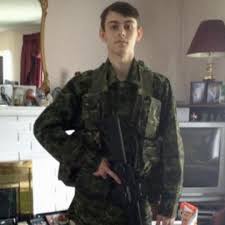 That changed on July 22 as word of MacLeod and Schmegelsky’s disappearance circulated through Port Alberni’s community. Police learned from youth sources there was strong suspicion Bryer Schmegelsky had a dark side and Kam McLeod had one, too. Police heard that Schmegelsky spent hours viewing online material about twisted acts, and he’d made social media posts with Nazi and extremist regalia. It was also alleged that Schmegelsky made verbal threats to shoot random people and then commit suicide.
That changed on July 22 as word of MacLeod and Schmegelsky’s disappearance circulated through Port Alberni’s community. Police learned from youth sources there was strong suspicion Bryer Schmegelsky had a dark side and Kam McLeod had one, too. Police heard that Schmegelsky spent hours viewing online material about twisted acts, and he’d made social media posts with Nazi and extremist regalia. It was also alleged that Schmegelsky made verbal threats to shoot random people and then commit suicide.
The RCMP investigation team processed what was left of McLeod’s Dodge Ram. They found a charred metal cartridge container holding military surplus rounds of SKS ammunition. The police also learned McLeod legally purchased a non-restricted SKS semi-automatic assault rifle at a Cabalas store near Port Alberni on the day he and Schmegelsky left home.
The Royal Canadian Mounted Police now considered Kam MacLeod and Bryer Schmegelsky viable suspects in the planned and deliberate Deese, Fowler and Dyck murders. They swore charges and obtained arrest warrants with Canada-wide jurisdiction. The RCMP also issued a nation-wide public warning, and the already over-heated media attention broadcast the story around the world.
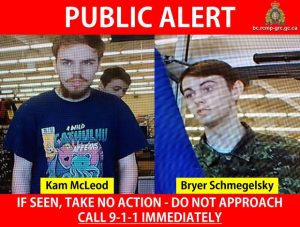 The Schmegelsky-McLeod story generated hundreds of tips. Some were far-out, but a few were deadly accurate. Soon, the detective team established a travel pattern for the pair as they drove Dyck’s stolen SUV 2,000 miles (3,200km) eastward across the Canadian provinces of British Columbia, Alberta, Saskatchewan and Manitoba. The trip took them four days, and their trail ended at the extremely remote northern Manitoba town of Gillam.
The Schmegelsky-McLeod story generated hundreds of tips. Some were far-out, but a few were deadly accurate. Soon, the detective team established a travel pattern for the pair as they drove Dyck’s stolen SUV 2,000 miles (3,200km) eastward across the Canadian provinces of British Columbia, Alberta, Saskatchewan and Manitoba. The trip took them four days, and their trail ended at the extremely remote northern Manitoba town of Gillam.
The Manhunt on Foot Begins
On July 23, Leonard Dyck’s RAV4 turned up east of Gilliam in an area called Sundance Camp near the Bird First Nations settlement of the Cree people. It was on fire. Police from Gillam were already alerted about McLeod and Schmegelsky from country-wide bulletins and the massive mainstream news coverage.
There was no doubt the fugitives reached the end of the road, but there was no sign of them personally at Sundance. This area is inhospitable, to say the least, and the thought of two inexperienced boys taking on wilderness survival seemed absurd. The thick forest and bog teemed with flies, and the woods harbored dangerous predators like polar bears, black bears and timber wolves.
Little by little, as the ground search progressed, clues appeared that proved the pair were on foot and moving east along the banks of the massive Churchill River and towards Hudson Bay. Searchers found clothing and identification as well as SKS ammunition boxes belonging to Schmegelsky and McLeod. It appeared they were lightening their load.
While the main ground search focused on the Sundance area, inevitable red herrings occurred. Search efforts diverted to a distant location after a seemingly credible sighting placed two suspicious young men near a landfill. Other reports came in from miles away in Ontario which also claimed valuable investigative resources. Ridiculously, internet sites like Facebook Groups bashed the police and trolls encouraged the killers.
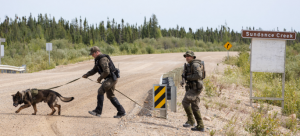 The RCMP had help from the Canadian military in their search for McLeod and Schmegelsky. Two high-tech search planes used sophisticated tracking equipment but came up empty. So did the Emergency Response Team and canine units beating the bush and risking their lives to an ambush. By August 3, 2019, the police were ready to scale back and conclude that the pair had perished. Things suddenly changed.
The RCMP had help from the Canadian military in their search for McLeod and Schmegelsky. Two high-tech search planes used sophisticated tracking equipment but came up empty. So did the Emergency Response Team and canine units beating the bush and risking their lives to an ambush. By August 3, 2019, the police were ready to scale back and conclude that the pair had perished. Things suddenly changed.
Schmegelsky and McLeod are Found Dead
A seasoned river guide reported a suspicious find on the Churchill River’s banks. He’d spotted a small boat trapped along the shore 5 miles (8km) east of Sundance where the burnt RAV4 was found. Police suspected McLeod and Schmegelsky may have stolen the boat and fled downriver. Possibly, the theory went, the pair might have capsized and drowned.
This area had already been searched from the air with no luck. However, a ground search hadn’t been done due to the prohibitive terrain, and previous runs on the river were negative. Police efforts zeroed-in on the north shore of the Churchill River close to Sundance, and they hired a talented man to guide them.
 Billy Beardy was well-known in the Cree community for his outdoor skills. Beardy was a life-long Bird First Nations resident and a top-notch hunter and trapper. He was also a master riverboat operator.
Billy Beardy was well-known in the Cree community for his outdoor skills. Beardy was a life-long Bird First Nations resident and a top-notch hunter and trapper. He was also a master riverboat operator.
Beardy took an RCMP team of trackers and divers to the found-boat site. They found nothing in the water, but they located more belongings that McLeod and Schmegelsky dropped on the land. This evidence enhanced police suspicions that Canada’s most-wanted youths were somewhere nearby.
It was Billy Beardy who solved the mystery. On August 7, Beardy made another river run with the police. He saw something only a woodsman would recognize. From a steep draw tangled with bush on the north river bank, 3 miles (5km) from the burned RAV4 site, a raven swooped up as the boat went by. Beardy recognized it as a carrion site, and the scavenging bird was feeding on meat.
Billy Beardy turned his jetboat and carefully navigated his craft through the fast-flowing water. Approaching the shore, Beady and his police crew saw Kam McLeod’s body on the bank along the river edge. Nearby—also dead—was Bryer Schmegelsky.
RCMP Recover Evidence from the Death Site
Beside Schmegelsky and McLeod’s bodies were two SKS rifles. One was the legally-bought firearm McLeod purchased on July 12. The other was a black market weapon assembled from various SKS components. Both rifles were later conclusively linked through forensics as being the Deese, Fowler and Dyck murder weapons.
The police also recovered a video camera that belonged to Leonard Dyck. In its video bank were six recordings made by Schmegelsky and McLeod where they confessed to murdering their three victims and making a suicide pact. The two stated they had no accomplices or outside help, but they made no comment about their motive or rationale for these senseless acts. They showed no remorse.
The RCMP’s report states that, in the end, McLeod shot Schmegelsky in a suicide pact. Then he turned the gun on himself. It appears the pair earlier torched the RAV4, then walked east along Churchill River’s high bank, They likely descended for drinking water and got trapped at the bottom of a steep ravine along the high river bank. They were unable to climb back up and were blocked by the river torrent below. Their situation was hopeless, and they refused to be captured.
The police report doesn’t speculate on when the pair expired. The coroner found both died from single gunshot wounds which were immediately fatal. And the report concluded Bryer Schmegelsky and Kam McLeod were the sole killers responsible for tragically taking three other lives.
Schmegelsky and McLeod’s Motive for Killing Deese, Fowler and Dyck
Motive is the real mystery in this senseless story of two killer kids. Their pre-death confession took full responsibility for the murders, but they gave no hint of their reason for callously causing these innocent peoples’ deaths. It seems their motive will never be known.
We’ll never know exactly what Schmegelsky and McLeod said in their videos. Wisely, the RCMP deferred to their Behavioral Analysis Unit and a world-renown forensic psychiatrist for advice. They were told to keep the video content sealed forever, and this is the report’s rationale:
“The RCMP Behavioral Analysis Unit (BAU) conducted a review of the videos of McLeod and Schmegelsky. BAU was concerned with a behavior called “identification”, which is considered a “warning behavior” in the context of threat assessment. In that, the videos may influence or inspire other individuals to carry out a targeted act of violence, essentially creating copycat killers. In BAU’s experience, those who commit mass casualty attacks are heavily inspired by previous attackers and their behaviors.
The BAU consulted with Dr. Reid Meloy, a forensic psychologist and a world-leading expert in threat assessment and he agreed that the videos should not be released. His and others research has shown that those individuals who commit mass casualty attacks are often heavily inspired by previous attackers and their behaviors.
BAU believed that McLeod and Schmegelsky may have made the video recordings for notoriety and releasing them will be seen as an injustice to the victims and their families. In an effort to not sensationalize the actions of McLeod and Schmegelsky and to mitigate the potential of other individuals being inspired by McLeod and Schmegelsky to commit similar acts of violence, the videos will not be released to the public by the RCMP.”
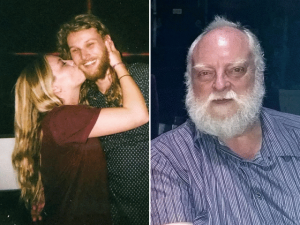 What Bryer Schmegelsky and Kam McLeod did to Chynna Deese, Lucas Fowler and Leonard Dyck is inexcusable. It’s indefensible and beyond justification. Their motive—whatever it was—is unfathomable and incapable for the rational mind to understand.
What Bryer Schmegelsky and Kam McLeod did to Chynna Deese, Lucas Fowler and Leonard Dyck is inexcusable. It’s indefensible and beyond justification. Their motive—whatever it was—is unfathomable and incapable for the rational mind to understand.
This isn’t an issue of two troubled youths ignored by an uncaring society and acting out. It’s not a case of desperate fleeing felons. No. What these killer kids did for perverted gratification is beyond sick and disgusting. It’s a truly senseless story.

